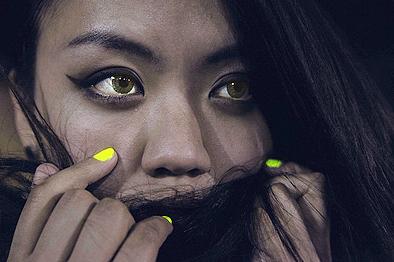The Museum of Contemporary Art, Taipei (MOCA, Taipei) currently has two exhibits by foreign artists who explore different aspects of Taiwan. Nocturnal Taipei (夜越台北) presents photography and film by Dutch artist David Verbeek and includes RU There, a feature-length romance flick shot in Taipei and selected for competition at the Cannes Film Festival. Verbeek’s solo show also features 65 photographs of Taipei’s nightlife. Brenda Zlamany’s Project 888: Portraits of Taiwan (八八八計畫:看我←→畫我←→拍我) examines the multifaceted nature of portraiture in the digital age. The US-based artist traveled to Taiwan to find subjects and combines painting, performance art and photography to challenge traditional ideas of portraiture.
■ Nocturnal Taipei is currently on view at MOCA Studio, Museum of Contemporary Art, Taipei (MOCA, Taipei), 39 Changan W Rd, Taipei City (台北市長安西路39號), tel: (02) 2552-3720. Open Tuesdays to Sundays from 10am to 6pm. Admission: Free. Regular ticket prices: NT$50. Until Feb. 28
■ Project 888 is currently on view at MOCA Studio — Underground (地下實驗‧創意秀場), Zhongshan MRT Station (中山捷運站) Exit 6. Until Feb. 29

Photo Courtesy of MOCA, Taipei
Several museums in Taiwan are marking the Year of the Dragon with exhibits celebrating the mythical beast. The dragon is an emblem of Chinese culture symbolizing potent and auspicious powers, particularly control over the elements, success, prosperity and good luck. Faces of the Dragon (龍年龍相) brings together 15 works by Chung Yung-ho (鐘永和) and Chinese photographer Li Zhong (李忠). Chung captures images of dragons common in Taiwan’s folk culture, such as dragon boats. Li depicts landscapes in which dragon shapes and outlines can be discerned.
■ National Museum of History (國立歷史博物館), 49 Nanhai Rd, Taipei City (台北市南海路49號), tel: (02) 2361-0270. Open Tuesdays to Sundays from 10am to 6pm. General admission is NT$30
■ Until Feb. 26
The Yingge Ceramics Museum has assembled 120 ceramic dragons for a show titled The Dragons Reinvigorated Amongst Us (活龍活現).
■ Yingge Ceramics Museum (鶯歌陶瓷博物館), 200 Wenhua Rd, Yingge Dist, New Taipei City (新北市鶯歌區文化路200號), tel: (02) 8677-2727. Open daily from 9:30am to 5pm. Closes at 6pm on Saturdays and Sunday. Admission: Free
■ Until Feb. 15
Dragon Blessings From Heaven (昇龍聚福) brings together 290 prints in a wide variety of mediums — digital prints, linocut prints, woodcut prints, silkscreen prints and mixed-media prints — to depict the Year of the Dragon and “reflect the artistic advances and tastes of our time,” according to the museum’s press release.
■ National Taiwan Museum of Fine Arts in Taichung (國立台灣美術館), 2, Wucyuan W Rd Sec 1, Greater Taichung (台中市五權西路一段2號), tel: (04) 2372-3552. Open Tuesdays to Fridays from 9am to 5pm and Saturday and Sunday from 9am to 6pm. Admission: Free
■ Until March 11
Call for submissions
The organizers of the Urban Nomad Film Festival are accepting submissions from Taiwanese and foreign nationals for its forthcoming film festival, which begins at the end of April. The deadline for feature-length films is Feb. 15; the deadline for short films (under 45 minutes) is March 1. NT$40,000 in prizes, including a jury prize of NT$20,000, are up for grabs in the short film category, which covers several genres, such as video art, documentary and skateboarding films. Urban Nomad will also consider proposals for VJ performances, installations and other genre-bending works. Staying true to their independent roots, the organizers “love weird stuff and will try to make cool shit happen.” For complete details in Chinese and English, visit www.urbannomad.tw

In the March 9 edition of the Taipei Times a piece by Ninon Godefroy ran with the headine “The quiet, gentle rhythm of Taiwan.” It started with the line “Taiwan is a small, humble place. There is no Eiffel Tower, no pyramids — no singular attraction that draws the world’s attention.” I laughed out loud at that. This was out of no disrespect for the author or the piece, which made some interesting analogies and good points about how both Din Tai Fung’s and Taiwan Semiconductor Manufacturing Co’s (TSMC, 台積電) meticulous attention to detail and quality are not quite up to

April 21 to April 27 Hsieh Er’s (謝娥) political fortunes were rising fast after she got out of jail and joined the Chinese Nationalist Party (KMT) in December 1945. Not only did she hold key positions in various committees, she was elected the only woman on the Taipei City Council and headed to Nanjing in 1946 as the sole Taiwanese female representative to the National Constituent Assembly. With the support of first lady Soong May-ling (宋美齡), she started the Taipei Women’s Association and Taiwan Provincial Women’s Association, where she

It is one of the more remarkable facts of Taiwan history that it was never occupied or claimed by any of the numerous kingdoms of southern China — Han or otherwise — that lay just across the water from it. None of their brilliant ministers ever discovered that Taiwan was a “core interest” of the state whose annexation was “inevitable.” As Paul Kua notes in an excellent monograph laying out how the Portuguese gave Taiwan the name “Formosa,” the first Europeans to express an interest in occupying Taiwan were the Spanish. Tonio Andrade in his seminal work, How Taiwan Became Chinese,

Mongolian influencer Anudari Daarya looks effortlessly glamorous and carefree in her social media posts — but the classically trained pianist’s road to acceptance as a transgender artist has been anything but easy. She is one of a growing number of Mongolian LGBTQ youth challenging stereotypes and fighting for acceptance through media representation in the socially conservative country. LGBTQ Mongolians often hide their identities from their employers and colleagues for fear of discrimination, with a survey by the non-profit LGBT Centre Mongolia showing that only 20 percent of people felt comfortable coming out at work. Daarya, 25, said she has faced discrimination since she